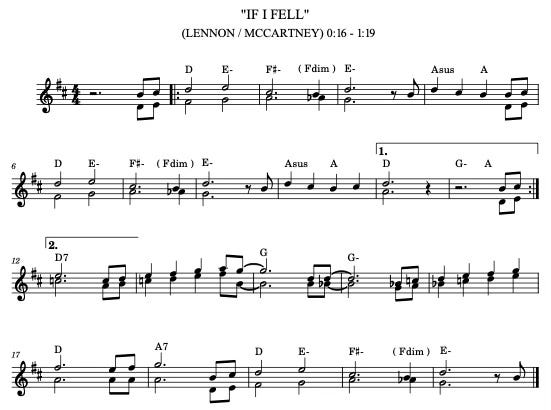Grapefruit Moon // March
new releases, some shows, and "always be singing:" or, How To Play Two Good Notes
Hi friends,
Thanks as always for diving in with me here. I released some new music last week and have some fun shows coming up, hope to see you somewhere! For paid subscribers, the exploration side of this month’s newsletter looks at a bunch of vocal duet recordings (Ella and Louis, John and Paul, Compay Segundo y Su Grupo) and asks what we can learn about framing melodies from these masterclasses in two-voice motion. Always be singing, no matter what instrument you play.
New record from Storm Jameson, Roll On Buddy out now via Flood Music
My sort-of-traditional-folk music duo, Storm Jameson, has a new record out called Roll On Buddy. An excerpt from our little blurb describes the music well:
Roll On Buddy features gorgeously stripped-down arrangements of traditional and popular songs spanning over one hundred years of music from Ireland, Canada, and the US. Cut in a single day session – then minimally embellished with pedal steel, bass, and fiddle – the emotional intimacy of these takes is fully on display across the record's eight selections.
We love these songs, and the pressing sounds beautiful. The session for this record was swift — no headphones, not many takes, lots of vulnerability. Shout out to Jim for cutting all the vocals live in one day with no edits.
You can pick up a record via Bandcamp; we’ll also be celebrating the release on 3.27 with a show at Judson & Moore here in Chicago.
My partner Anabel released an extraordinary 8-song, 13-minute opus of experimental pop music under the name Tortellini Hot. I produced, engineered, and mixed. Doop Doop Music is out now, exclusively on Bandcamp and YouTube.
Here’s where I’m playing this month:
3.14 @ Studio 5 (Evanston, IL) with the Oh Yeahs (in support of their new record, on which I play guitar and a little pedal steel)
Three concerts with Christian Dillingham’s quartet, also supporting a recent release (and also on which I play guitar and a little pedal steel), all via Rendezvous Arts’ Chamber Music series:
3.19 @ The Next Picture Show (Dixon, IL)
3.21 @ The Gorton Center (Lake Forest, IL)
3.23 @ Artifact Events (Chicago, IL)
3.27 @ Judson & Moore Distillery with Storm Jameson [record release show] and Alta Vista
3.28 @ the Hungry Brain with Sidepieces
I’ll be playing some original trio music (with Junius Paul on bass and Quin Kirchner on drums) out at Fitzgeralds on 4.10, early heads up for that one too.
I’ve also been opening my teaching practice back up this year; if anyone is interested in in-person or remote lessons, feel free to drop a line via my website. The musical exploration section below is a window into some of the things I’m tinkering with in my own practice, so if you’re just looking for some ideas to kickstart your own independent study, please consider jumping onto the paid tier of Grapefruit Moon. Thanks everyone! - M
Two Good Notes
Always be singing — I would say this is one of my most closely held artistic ideals. Always be singing, and always be drumming. If everything we play on our instrument can be an extension of our voice, and we can deliver our ideas with deep rhythmic intention, I think most of our job is complete.
Singing through the instrument can be an elusive notion as a purveyor of mostly plucked strings, where notes go to die (in the sense that they decay — I think most guitarists would love to be able to play a note that gradually moves more air as it goes on).1 But connecting the voice to the hands is at the core of everything I’m trying to do in music, regardless of the situation. And so, I find myself spending a lot of time thinking about the best way to render a melody.
The guitar thrives on dyads — that is, a two-note voicing that registers as melody with a second voice harmonizing it along the way. Some of my favorite guitar playing is built from this idea: much of the west African guitar music leans on guitars playing in 6ths, 3rds, or 4ths (see Franco Luambo’s Congolese rumbas2, Koo Nimo’s palm wine guitar3, tons of soukous, makossa and highlife4, etc); I also hear Cornell Dupree in my mind, or Steve Cropper, or James Burton when I think about playing double stops in a melody-driven way…
It’s an intoxicating sound, that second voice tagging along. And as long as we know where to find those intervals on the instrument, it’s an easy avenue toward filling out the sound. But what if we want to create more variation, more independence, more specificity for that bottom voice? What if we want the second voice to have its own melodic integrity and logic, instead of always following the top line in parallel?
By incorporating other intervals, countermelodies, contrary motion, and suspensions, we can tap into a much more dynamic way of supporting our melodies, helping to make the music feel more like two singers moving together. Which is why I’d like to look at some excerpts of exactly that - a few vocal duets that can show us the way.
Among the most classic vocal duets on tape, “If I Fell” is mostly made of parallel 6ths and 3rds, but occasionally breaks away into contrary motion (mm. 3-4, for example) and uses a static voice against a moving one (mm. 14-15 and 17-18, for example). A little goes a long way — dissecting a passage like this and getting both voices into your ears and hands (or play one voice and sing the other) can start to plant the seeds of finding these sounds in real time, improvising your way through harmonizing a melody with an independent second voice.
Here’s one from Cuban musician Compay Segundo. I’ve been spinning his recordings quite a lot over the last month, and translating a few pieces to the guitar — yet another great example of hearing the second voice following in rhythmic unison and picking its moments to branch off from the parallel harmonization of 3rds and 6ths. Some spots I especially love: the contrary motion in mm. 4 and 14, where the voices start an octave apart and arrive back at that close 3rd; the tritones in mm. 6, 16, and 26; and mm 28, so much in this one bar! Two tritones of D#/A and F#/C, the appoggiatura of the high A to give us a 6th before descending to that second tritone, and finally the outward resolution to G/B. The result is two distinct melodies, rather than the bottom voice blindly tethered to the top, the easy way out.
Again, I really feel like absorbing these gestures in your ears and accessing them on an instrument opens the door to freely playing this way, whatever the piece of music may be.
Another way to approach this type of accompaniment is by allowing the second voice to have a rhythmic life of its own. I love these Ella and Louis recordings; it can be striking to offer your own conversational counterpoint to your melodies, imagining two separate personalities as you play. Louis is the bottom voice here, interjecting phrases and finding landing points to harmonize in a simple but freewheeling way.
I’ll finish this exploration with a quick recording of me playing through “In the Wee Small Hours of the Morning” using just two voices — trying to hear my way with both lines, trying to build upon some of the wisdom in the above recordings, trying to be both singers in an imagined duet:
Always be singing,
Matt
At the same time, I think we guitarists also wear the inevitable ending and deterioration of notes proudly as a sort of badge of tragic/dramatic flair — surely overcompensating for all the wildly over-the-top guitar music out there.






